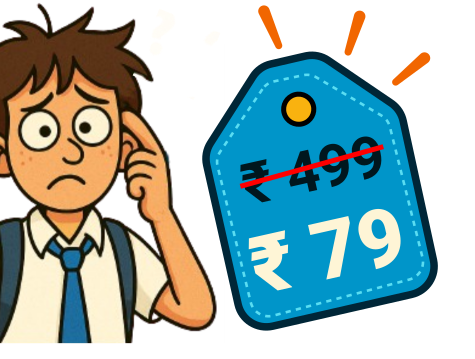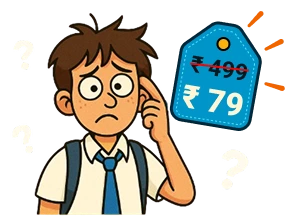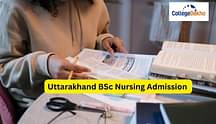
Solving
CAT DILR practice questions with answers
is crucial for aspiring candidates aiming to crack the exam to secure admissions in India's top management institutes like the IIMs. This section tests the ability to critically analyse data and make logical conclusions, which is indispensable for future managers in decision-making processes. Engaging in practice questions enhances problem-solving skills, speed, and accuracy under time constraints. By working through varied questions, candidates can familiarise themselves with different types of puzzles, charts, and caselets, reducing the surprise element in the actual exam. Furthermore, solutions provide deeper insights into problem-solving techniques and strategies, allowing candidates to learn and apply shortcuts and tricks, ultimately boosting their confidence and performance in the DILR section of the
CAT 2025 exam
. In this article, we have included essential CAT 2025 DILR practice questions with answers. These are meant to help candidates assess their skills and get accustomed to the question patterns.
Also Read:
CAT DILR Exam Pattern 2025 Overview
Before we dive into the CAT 2025 DILR practice questions with answers, let us quickly understand the CAT 2025 exam pattern to get a brief idea about this section:
Sections | Duration | No. of MCQ's | No. of Non-MCQs | Total |
|---|---|---|---|---|
VARC | 40 Minutes | 20 | 4 | 24 |
DILR | 40 Minutes | 12 | 8 | 20 |
QA | 40 Minutes | 14 | 8 | 22 |
Total | 2 Hours | 46 | 20 | 66 |
Top CAT 2025 DILR Practice Questions with Answers
Here are a few top CAT 2025 DILR practice questions and answers to help you ace the section:
Problem Statement 1
Sixty-four players, ranging from seed 1 to seed 64, took part in a single-elimination tennis competition. Seed 1 holds the top position, while seed 64 holds the bottom. The tournament unfolds across six stages: the first round, second round, third round, quarterfinals, semifinals, and the showdown.
In the initial round, the player with the highest seed (seed 1) engages in Match No.1 against the player with the lowest seed (seed 64). This pattern continues as the second-highest seed (seed 2) faces off against the second-lowest seed (seed 63) in Match No.2, and so forth. The subsequent rounds follow a similar structure, with winners progressing to the next stage.
Now, let's dive into the questions:
Question 1: If the player seeded 43 emerges victorious, which of the following players cannot be the runner-up?
Player seeded 44
Player seeded 45
Player seeded 46
Player seeded 36
Question 2: Who might be the lowest-seeded player competing against the player seeded 12th in the finals?
57
59
62
63
Question 3: If a match features players seeded 23 and 46, which of the following pairs could engage in another match in the tournament?
9 and 13
6 and 18
5 and 51
17 and 15
Question 4: With only five upsets in the tournament, who has the potential to be the lowest-seeded player to win the entire competition?
16
17
63
32
Solutions (Questions 1 to 4)
Solution to Question 1: The diagram above indicates that if the player seeded 43 advances to the finals, the player seeded 46 is precluded from reaching the final since they occupy the same half of the draw. In each half of the draw, only one person progresses to the finals.
Answer: Choice 3
Solution to Question 2: Given the presence of the player seeded 12 in the top half of the draw, the lowest-seeded player in the bottom half, i.e., the player seeded 63, has the potential to compete with them in the final.
Answer: Choice 4
Solution to Question 3: Dividing the above diagram into four sections, with 46 falling into the third part and 23 into the fourth part, it follows that, apart from players seeded 23 and 46, none of the players in the third or fourth part can engage in a match with those in the other three groups. Consequently, only the match between players seeded 9 and 13 is plausible among the given choices.
Answer: Choice 1
Solution to Question 4: To secure victory in the tournament, any player must triumph in six matches. With five upsets in play, the player seeded 32 has the potential to emerge as the tournament winner.
Answer: Choice 4
Problem Statement 2
Amit, Basheer, Chris, Dharam, and Esso comprise a group of five friends, each with a distinct height. They are assigned position numbers based on their heights, ranging from 1 for the tallest to 5 for the shortest.
The sum of Amit's position number and Esso's position number equals the sum of Dharam's position number and Chris' position number. Notably, Chris is not the shortest, and Amit is not the tallest. Furthermore, Chris is shorter than Amit, and Dharam is shorter than Basheer.
Now, let's address the questions:
Question 5: Who is the tallest?
Basheer
Amit
Esso
Either Basheer or Amit
Cannot be determined
Question 6: If Dharam is shorter than Chris, then the sum of the position numbers of which of the following combinations is/are a perfect square?
Basheer and Amit
Dharam and Esso
Chris and Basheer
More than one of the above
None of the above
Question 7: If Dharam is shorter than Chris, then which of the following is true?
Arrange individuals based on their height in descending order, ensuring that individuals with names starting with consecutive letters in the alphabet are not positioned next to each other.
The sum of the position numbers of Chris and Amit is equal to the position number of Esso.
The sum of the position numbers of Dharam and Esso is a prime number.
Basheer is not taller than Chris.
None of the above
Solutions (Questions 5 to 8)
Amit falls short of being the tallest, and Chris doesn't hold the title of the shortest. Furthermore, Amit surpasses Chris in height, and Basheer outstrips Dharam. Given that Chris is shorter than Amit but not the briefest in stature,
Amit cannot be assigned the position number 5.
Similarly, Chris cannot occupy position number 2.
Basheer cannot be the most diminutive, given that his stature surpasses Dharam's. Dharam, therefore, cannot hold position number 1.
This leads us to the possibilities:
Amit (A) —> 2, 3
Basheer (B) —> 1, 2, 3, 4
Chris (C) —> 3, 4
Dharam (D) —> 2, 3, 4, 5
Esso (E) —> 1, 2, 3, 4, 5
Now, A + E = C + D.
However, C can only be 3 or 4, and neither A nor D can be 1.
Thus, C + D = (3 + 2) or (2 + 3) is not viable, leaving A + E as (1 + 4) or (4 + 1), and A cannot be 1 or 4.
Therefore, C + D = 3 + 4 is feasible.
Hence, A + E = 2 + 5 (Equation 1)
Similarly, C + D = 4 + 3 (Equation 2)
This establishes that Basheer is 1" in both scenarios.
Answer to Question 5: Basheer is the tallest. Choice (1)
Answer to Question 6: Chris + Basheer = 3 + 1 = 4 = (2). Dharam + Esso = 4 + 5 = 9 = 3. Choice 4
Answer to Question 7: Statement (1) is false, as the arrangement is as follows:
Statement (2) is true since Chris + Amit = 3 + 2 = 5 = Esso’s number. Choice 2
Problem Statement 3
In a store, five articles—P, Q, R, S, and T—are available for sale at distinct cost prices and selling prices, ranging from Rs. 650 to Rs. 900. Each article has a unique cost price and selling price, and no article is sold at the same price it was acquired. Key information is provided through the following statements:
(1) The cost price of article R matches the selling price of article T, and both incurred a loss during their sale.
(2) The cost price of Q exceeds that of S, and the shopkeeper garnered a profit from selling Q.
(3) The profit from selling any article surpasses Rs. 350, and the profits on different articles are not identical. Similarly, the losses incurred on any two articles are distinct.
(4) Profit was realised on only two articles, and the profit or loss on any article is not Rs. 150.
Now, addressing the questions:
Question 8: What is the selling price (in INR) of article P?
700
750
850
900
Question 9: What is the difference (in INR) between the cost price and the selling price of article Q?
50
250
200
100
Question 10: Whose selling price is INR 3700?
Q
R
S
T
Question 11: Which of the following statements is true?
The selling price of S is INR 3700.
The profit from selling P is INR 3200.
The cost price of T is not INR 3750.
None of these
Solutions (Questions 8 to 11)
Given a profit greater than 50 and a profit of 150, we can deduce that the profits can take any two values among 100, 200, and 250. If one of the profits is 250, the other profit cannot be 200.
Considering that 250 equals 900 minus 650 and 200 equals either 850 minus 650 or 900 minus 700, the latter scenario is not feasible.
One profit is 100, and the other is 200/250. Also, 100 equals 750 minus 650 or 850 minus 750.
Since neither R nor T made a profit, and the selling price or cost price of the article on which a profit of Rs. 100 was made is not Rs. 750, denoted as a ≠ 750. As a + > a > a −, a ≠ 650, 900, therefore a can only be 700 or 850.
Similarly, for b + > b > b −, b ≠ 650, 900. If b equals 850, then b + must be equal to 900, leading to a profit of Rs. 50, violating condition (3). Therefore, b can only be 700 or 750.
Considering the profit is greater than Rs. 350 and not equal to Rs. 3150, the possibilities for (b, b + ) are (700, 900) and (750, 850).
If a equals 850, then a + must be equal to 900. Also, (b, b + ) equals (700, 900), meaning a profit of 200 is made on selling Q.
Therefore, b − must be equal to 650, resulting in a profit of 100 on selling S, and the selling price of S must be 900, as the profits on no two articles are the same. Consequently, the selling price of P is Rs. 750.
Condition (4) indicates that the cost price of P cannot be Rs. 3900. Thus, the cost price of P is Rs. 3850, and that of T is Rs. 900.
Hence,
Answer to Question 8: Choice 2 is accurate, as the selling price of P is INR 3750.
Answer to Question 9: The correct difference is 250, as calculated by subtracting 650 from 900. Choice 2 stands correct.
Answer to Question 10: Choice 4 accurately states that the selling price of T is INR 3700.
Answer to Question 11:
The only true statement is Choice 3.
Also Read:
Problem Statement 4
In a family of eight members—P, Q, R, S, T, U, V, and W—spanning three generations, there are three married couples, and two individuals remain unmarried. Each couple has at least one child. Within this family, each person is employed by one of the companies: A, B, C, D, E, F, G, or H, with no repetitions.
V and F are the only siblings in the family, while U, W, R, and S share the same gender. Notably, W and V are not a married couple.
The individual working with A is the mother of the individual working with F, who is a female. V, who is not employed by E, has a daughter named S. R is employed by B. The person working with G and the person working with E belong to the same generation. The person working with G is a female, whereas the person working with E is a male. The individual working with C is the maternal grandfather of Q, who, in turn, works with D. Finally, T is employed by H.
Now, let's address the questions:
Question 12. At which company is W employed?
H
G
F
A
Question 13. Who is the spouse of the individual working with E among the following?
R
S
W
The individual working with E is unmarried.
Question 14. Among the options, which pairs of individuals are confirmed to be a married couple?
V and U
S and T
R and T
none of the above
Question 15. Which of the following statements is true?
U are employed at A.
W is P's daughter.
Q is male.
None of the above
Solutions (Questions 12 to 15)
Given the following conditions:
(1) The 8 family members span three different generations.
(2) The family consists of three married couples, with two unmarried individuals.
(3) Each married couple has at least one child.
From these conditions, two possibilities arise. The family members are labelled as F1, F2, ..., F8.
Let's explore possibility (I):
V and R are identified as the only siblings. Assign F3 as V and F4 as R. V has a daughter, 8, making F7 S. Consequently, U, W, R, and S are females. The person working with C is Q's maternal grandfather, so F8 is Q, who works with D, while F1 works with C. R works with B.
The person working with A is the mother of the person working with F, and both are females. F5 (V's wife) works with A, and her daughter works with F. However, this setup conflicts with the condition that the individuals working with G and E must be of the same generation. Therefore, this case is not viable.
Consider possibility (II):
This possibility has two sub-cases:
Case (a): F2 is R. In this scenario, F3 is V, and F is the individual working with C. F6 is S, F8 is Q, and F4 is U, who works with A. This arrangement places F7 and F5 in E and G, respectively. However, V working with H is not feasible, rendering this case invalid.
Case (b): F2 is V. F3 is R, and V works with C. F5 is S, F8 is Q and works with D. As W is not V's spouse and is female, she can't be F4 or F7. Hence, F6 is W, F1 is U working with A, and S works with F. The individuals working with G and E must be in the same generation, leading to W working with G and F7 working with E. F4 works with H, so F4 is T, and F7 is P.
The final arrangement is as follows:
Answer to Question 12: W works with G. Answer: Choice (2)
Answer to Question 13: S is the wife of the person who works with E. Answer: Choice (2)
Answer to Question 14: V and U are a married couple, and so are R and T. Answer: Choice (4)
Answer to Question 15: Only choice (1) is true. Answer: Choice (1)
Also Read:
CAT 2025 DILR High-Yielding Topics
The DILR section in the CAT exam has two broad categories of questions: Data Interpretation and Logical Reasoning. In the DI section, you are required to interpret elaborate data, usually shown in tables, charts, or graphs. The LR section tests how logically and rationally you can think and solve complex problems in less time. The difficulty level of this section differs every year. It may be easy one year, slightly difficult the next, or even very difficult. By solving CAT previous years’ question papers , you will get an idea of the trend.
Topic | CAT 2020 | CAT 2021 | CAT 2022 | CAT 2023 | ||||||||
|---|---|---|---|---|---|---|---|---|---|---|---|---|
Slot 1 | Slot 2 | Slot 3 | Slot 1 | Slot 2 | Slot 3 | Slot 1 | Slot 2 | Slot 3 | Slot 1 | Slot 2 | Slot 3 | |
Routes and Networks | - | - | - | - | - | - | 5 | 5 | - | - | - | 5 |
Tables | - | 10 | - | - | 6 | - | - | - | - | 5 | 5 | 5 |
Scheduling, Optimisation, and allocations | 6 | 6 | 6 | 4 | - | - | 5 | - | 5 | 10 | - | - |
Bar Graphs | - | - | - | 4 | 4 | - | - | - | 5 | - | - | - |
Grids | 10 | 8 | 6 | 6 | - | - | - | - | 5 | 5 | 5 | 5 |
Arrangments | - | - | - | 6 | 6 | 6 | 5 | - | - | - | - | - |
Word Puzzles | - | - | 4 | 4 | 6 | - | - | - | - | - | - | |
Games and Tournamnets | - | - | - | - | - | - | - | - | - | - | - | - |
Math Puzzles | - | - | 4 | - | - | 4 | - | 5 | 5 | - | 5 | 5 |
Venn Diagrams | 8 | - | 4 | - | - | - | 5 | 5 | - | - | - | - |
Pie Charts/Doughnut Charts | - | - | - | - | - | - | - | - | - | - | - | - |
Scatter Plot | - | - | - | - | - | - | - | 5 | - | - | - | - |
Coding/Decoding | - | - | - | - | - | - | - | - | - | - | - | - |
Radar Chart | - | - | - | - | - | - | - | - | - | - | - | - |
Gantt Chart | - | - | - | - | - | 4 | - | - | - | - | 5 | - |
How to Answer CAT 2025 DILR Exam Questions?
It is not merely about answering more and more questions—it is about answering the CAT 2025 DILR questions cleverly and efficiently within the time limit.
- Begin with Understanding the Question Patterns: Take time to study the type of DILR questions that are usually found in the CAT exam. Once you know the pattern and types of sets, it is easier to control your time and select appropriate questions in the test. Avoid wasting time on difficult sets that can eat into your sectional time limit.
- Study the Correct Techniques: Each section has its own tricks, and DILR is not an exception. Be it books or coaching materials, ensure you learn and implement the solving techniques they provide. If you approach questions with a well-thought-out strategy, you will end up solving them quicker and more accurately.
- Create a Mental Reference Sheet: You will encounter puzzles, seating plans, Venn diagrams, and other intricate problems in DILR. It is simple to get confused. To prevent confusion, become accustomed to using short forms, abbreviations, and symbols while practising. Consider creating your own mental 'cheat sheet' to make things easy during the exam.
- Learn to Decode Hidden Clues: Most DILR questions are made to befuddle you. There will always be implicit clues or constraints which are not easy to notice at first glance. Practice reading between the lines and noticing these little things; they will make answering the question much easier and faster.
- Concentrate on Your Speed Improvement: Lastly, develop the habit of checking your performance. Improve your speed without sacrificing accuracy. Regularly practice mental calculations so you can save time, particularly when answering data interpretation questions.
In conclusion, the CAT Data Interpretation and Logical Reasoning (DILR) section can be challenging for many aspirants due to its lack of a defined syllabus and evolving difficulty over the years. However, consistent practice is the key to mastering this section. As the distinction between Data Interpretation and Logical Reasoning has diminished, candidates need to adapt to solving high-quality puzzles efficiently. This article provides essential practice questions to help candidates familiarise themselves and navigate the complexities of the DILR section, ultimately guiding them to success in the CAT exam.
Related Links:
We hope the above article was useful in providing a better understanding of the questions given in the CAT DILR section. For any further queries, feel free to post your questions in our CollegeDekho QnA section or call us at 1800-572-9877.
Are you feeling lost and unsure about what career path to take after completing 12th standard?
Say goodbye to confusion and hello to a bright future!

FAQs
Yes, the CAT 2025 DILR practice questions may be asked in the exam. Since these practice questions are taken from various sources like CAT previous year question papers, CAT sample papers, CAT mock tests, etc. they have a tendency to appear in the exam in one form or another.
The most common questions in the CAT DILR section are asked from topics like Blood relations, syllogisms, bar graphs, pie charts, coding decoding, etc. However, there are no fixed topics which are aksed in the exam and each year the topic-wise weightage for CAT DILR changes.
There is no fixed amount of time required to complete the CAT DILR syllabus. Since the CAT DILR syllabus is quite vast and includes complicated topics, every student will need a different amount of time to complete the same. If you are starting your CAT 2025 preparation from scratch, you should have at least six months time to complete the entire syllabus.
Whether you should practice CAT 2025 DILR practice questions separately or along with the entire question paper depends on your level of preparation. If you have only completed or are in the process of completing the CAT DILR syllabus, practicing the CAT 2025 DILR practice questions separately might be advantageous. However, if you have completed the entire syllabus, you should attempt the entire question paper to enhance your exam skills.
Was this article helpful?




















Similar Articles
How to Exercise AP ICET Web Options 2025?
AP ICET 2025 Rank-wise College List for MCA
Total Questions in CAT 2025: Past Year Trends & Insights
25+ CAT Quant Practice Questions with Solutions PDF Download
TS ICET 2025 Free Seat Rank: Cutoff, Eligibility, Counselling, How to Apply
MBA Colleges Accepting Low TS ICET 2025 Ranks